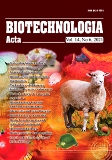ISSN 2410-7751 (Print)
ISSN 2410-776X (Online)

Biotechnologia Acta Т. 14, No. 6 , 2021
P. 53-59, Bibliography 9, Engl.
UDC: 577.112.7: 612.115
https://doi.org/10.15407/biotech14.06.053
OBTAINING OF PLANT TISSUE CULTURE Scutellaria baicalensis GEORGI. AND ITS BIOCHEMICAL ANALYSIS
О. О. Poronnik 1, G. Yu. Myriuta 1, V. M. Anishchenko 2, R. V. Ivannikov 2, V. A. Kunakh 1
1 Institute of Molecular Biology and Genetics of the National Academy of Sciences of Ukraine, Kyiv
2 Gryshko National Botanical Garden of the National Academy of Sciences of Ukraine, Kyiv
Aim. To obtain a plant tissue culture of S. baicalensis as a possible source of biologically active compounds (BAC) with a wide range of pharmacological action.
Methods. Plant tissue culture, photocolorimetric method, reversed-phase high performance liquid chromatography (HPLC) method.
Results. Two stably productive plant tissue culture strains (16SB3 and 20SB4) of S. baicalensis were obtained from fragments of roots seedling on a specially developed agar nutrient medium 5С01. The yield of dry biomass from 1 liter of this medium per passage (21st day of growth) for strain 16SB3 is 25–30 g, for strain 20SB4 – 30–40 g. The total content of flavonoids in dry biomass was in terms of routine for strains 16SB3 and 20SB4 – 0.6–0.9 and 0.7–0.9 mg/g, respectively, and the yield of flavonoids – 18–27 and 21–36 mg/l of nutrient medium, respectively. BAC typical for plants in nature, in particular, flavonoids vogonin, baikalein, neobaikalein, skulkapfavon and their derivatives, were found in the studied biomass of both strains.
Conclusions. It was found that the biomass of the two strains of S. baicalensis plant tissue culture accumulated the same BAC, in particular, flavonoids, as do plants in natural conditions. The resulting plant tissue culture is promising as a possible source of Baikal skullcap BAC.
Key words: Scutellaria baicalensis Georgi., plant tissue culture, flavonoids, strains – producers of biologically active compounds.
© Palladin Institute of Biochemistry of National Academy of Sciences of Ukraine, 2021
References
1. Khan T., Ali M., Khan A., Nisar P., Ahmad Jan S., Afridi S., Khan Z. Shinwari Anticancer Plants: A Review of the Active Phytochemicals, Applications in Animal Models, and Regulatory Aspects. Biomolecules. 2020, 10 (47), 2–30. https://doi.org/10.3390/biom10010047
2. Drygai A. M., Suslov N. I., Zyuzkov G. N., Kuzovkina I. N., Zhdanov V. V., Udut E. V., Guseva A. V., Vdovitchenko M. Yu., Shilova I. V., Smirnov V. Yu., Churin A. A., Voronova O. L., Simanina E. V., Neupokoeva O. V., Fedorova E. P. A drug with a hemo-stimulating, antimutagenic, antitumor, antimutagenic, antitumor, cerebroprotective, antihypotoxic, nootropic, anxiolytic and anti-neurotic action. Patent of the Russian Federation No 2438691 C1 MPK A61K 36/539. 2012, Byul. No 1. (In Russian).
3. Kunakh V. A. Biotechnology of medicinal plants. Genetic, physiological and biochemical basis. Kyiv: Logos. 2005, 724 p. (In Ukrainian).
4. Kunakh V. A. Plant biotechnology for human life improvement. Biotekhnolohiya. 2008, 1 (1), 28–39. (In Ukrainian).
5. Ohtsuki T., Himeji M. Fukazawa H. Tanaka M. Yamamoto H. Mimura A. High-yield production of scutellaria radix flavonoids (baicalein, baicalin and wogonin) by liquid-culture of Scutellaria baicalensis root-derived cells. Braz. arch. biol. technol. 2009, 52 (2), 291–298. https://doi.org/10.1590/S1516-89132009000200005
6. Wang Z.-L., Wang S., Kuang Y., Hu Z-M., Qiao X., Ye M. A comprehensive review on phytochemistry, pharmacology, and flavonoid biosynthesis of Scutellaria baicalensis. Pharmaceutical biology. 2018, 56 (1), 465–484. https://doi.org/10.1080/13880209.2018.1492620
7. Kunakh V. A., Alpatova L. K., Mozhilevskaya L. P. Nutrient medium for obtaining and growing callus tissues of plants. Patent of Ukraine № 10338A, IPC 6 C12N5/00, C12N5/02. Publ. 12/25/96, Bull. № 4. (In Ukrainian).
8. Navrotska D. O., Andreev I. O., Betekhtin A. A., Rojek M., Parnikoza I. Yu., Myryuta G. Yu., Poronnik O. O., Miryuta N. Yu., Joanna Szymanowska-Pu?ka, Grakhov V. V., Ivannikov R., Hasterok R., Kunakh V. A. Assessment of the molecular cytogenetic, morphometric and biochemical parameters of Deschampsia antarctica from its southern range limit in maritime Antarctic. Polish Polar Res. 2018, 39 (4), 525–524. https://doi.org/10.24425/118759
9. Ivannikov R., Laguta I., Anishchenko V., Skorochod I., Kuzema P., Stavinskaya O., Parnikoza I., Poronnik O., Myryuta G., Kunakh V. Composition and radical scavenging activity of the extracts from Deschampsia antarctica ?. desv. plants grown in situ and in vitroin vitro. Chemistry Journal of Moldova. 2021, 16 (1), P. 105–114. https://doi.org/10.19261/cjm.2021.841

